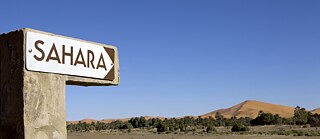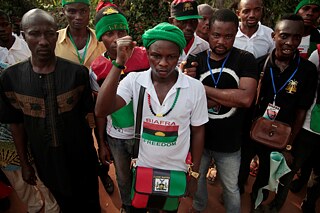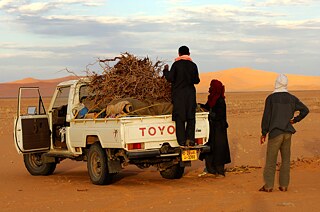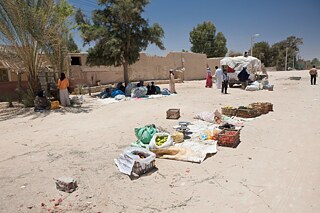What Is “Sub-Saharan Africa”? Geopolitics or Blatant Sophistry?

Morocco, Taouz, Merzouga, Erg Chebbi, signpost to Sahara desert | Photo (detail): Petra Stockhausen © picture alliance / Westend61
The reference to all of Africa except the predominantly Arab North as “sub-Sahara” not only defies the fundamentals of geography but also smacks of stereotypical racist labelling, according to Herbert Ekwe-Ekwe. An Essay by the late historian and political scientist.
It appears increasingly fashionable for a number of international broadcasters, news agencies, newspapers and magazines, the United Nations and its allied agencies, as well as some governments, writers and academics to use the term “sub-Saharan Africa” to refer to all of Africa (54 countries) except the 5 predominantly Arab states of North Africa (Morocco, Algeria, Tunisia, Libya, Egypt) and the Sudan, a north-central African country. Even though its territory is mostly located south of the Sahara Desert, the Sudan is excluded from the “sub-Saharan Africa” tagging by those who promote the use of the epithet because the regime in power in Khartoum describes the country as “Arab” despite its majority African population.Which Science?
But the concept “sub-Saharan Africa” is absurd and misleading, if not a meaningless classificatory schema. Its use not only defies the fundamentals of geography but also smacks of stereotypical, racist labelling. It is not obvious, on the face of it, which of the four possible meanings of the prefix “sub” its users attach to the “sub-Saharan Africa” labelling. Is it “under” the Sahara Desert or “part of”/“partly” the Sahara Desert? Or, presumably, “partially”/“nearly” the Sahara Desert or even the very unlikely (hopefully?) application of “in the style of, but inferior to” the Sahara Desert, especially considering that there is an Arab people sandwiched between Morocco and Mauritania (Northwest Africa) called Saharan?The example of South Africa is appropriate here. Crucially, this is a reference underlined in the relevant literature of the era especially those emanating from the West, the United Nations (principally UNDP, FAO, WHO, UNCTAD), the World Bank and IMF, the so-called NGOs/“aid” groups, and some in academia who all are variously responsible for initiating and sustaining the operationalisation of this “sub-Saharan Africa” dogma. The point is that prior to the formal restoration of African majority government in 1994, South Africa was never designated as part of “sub-Saharan Africa” by anyone in this portrait, unlike the rest of the 13 African-led states in southern Africa. The latter were often referred to, at the time, as the “frontline states” in reference to their strategic support for the historic African liberation movement across their borders in South Africa. South Africa then was either termed “white South Africa” or the “South Africa sub-continent” (as in the “India sub-continent” usage, for instance), meaning “almost” or “partially” a continent – quite clearly a usage of “admiration” or “compliment” employed by its subscribers to essentially project and valorize the perceived geostrategic potentials or capabilities of the erstwhile European-minority-led country. But soon after the triumph of the African freedom movement there, South Africa became part of “sub-Saharan Africa” in the quickly adjusted schema of this representation! What happened suddenly to South Africa’s geography for it to be so differently classified? Is it African liberation or rule that renders an African state “sub-Saharan”? Does this post-1994 West-inflected classification of South Africa make “sub-Saharan Africa” any more intelligible?
Morocco, Algeria, Tunisia, Libya and Egypt, the five Arab North Africa countries, do not, correctly, describe themselves as Africans even though they unquestionably habituate African geography, the African continent, since the Arab conquest and occupation of this Northern one-third of African territory in the 7th century CE. The Western governments, media and the transnational bodies, which are led predominantly by Western personnel and interests, have consistently “conceded” to this Arab cultural insistence on racial identity. Presumably, this accounts for the West’s non-designation of its “sub-Saharan Africa” dogma to these countries as well as the Sudan, whose successive Arab-minority regimes since January 1956 have claimed, but incorrectly, that the Sudan “belongs” to the Arab World. On this subject, the West does no doubt know that what it has been engaged in, all along, is blatant sophistry and not science.
It would appear that we still don’t seem to be any closer at establishing, conclusively, what its users mean by “sub-Saharan Africa”. Could it, perhaps, just be a benign reference to all the countries “under” the Sahara, regardless of their distances from this desert? Presently, there are 54 so-called sovereign states in Africa. If the 5 Arab states of North Africa are said to be located “above” the Sahara, then 49 are positioned “under”. The latter would therefore include all the 5 countries mentioned above whose north frontiers incorporate the southern stretches of the desert (namely, Mauritania, Mali, Niger, Chad and the Sudan), countries in central Africa (the Congos, Rwanda, Burundi, etc.), for instance, despite being 2000-2500 miles away, and even the southern African states situated 3000-3500 miles away! In fact, all these 49 countries, except the Sudan, which is clearly “under” the Sahara and situated within the same latitudes as Mali, Niger and Chad (i.e., between 10 and 20 degrees North of the equator), are all categorised by the “sub-Saharan Africa” users as “sub-Saharan Africa”. “sub-”s of the world?
New Classificatory Schema?
To replicate this obvious farce of a classification elsewhere in the world, the following random exercise is not such an indistinct scenario for universal, everyday, referencing:- Australia hence becomes “sub-Great Sandy Australia” after the hot deserts that cover much of west and central Australia.
- East Russia, east of the Urals, becomes “sub-Siberia Asia”.
- China, Japan and Indonesia are reclassified “sub-Gobi Asia”.
- Bhutan, Nepal, Pakistan, India, Sri Lanka, Bangladesh, Myanmar, Thailand, Laos, Cambodia and Vietnam become “sub-Himalaya Asia”
- All of Europe is “sub-Arctic Europe”.
- Most of England, central and southern counties, is renamed “sub-Pennines Europe”.
- East/southeast France, Italy, Slovenia, Croatia are “sub-Alps Europe”
- The Americas become “sub-Arctic Americas”.
- All of South America, south of the Amazon, is proclaimed “sub-Amazon South America”; Chile could be “sub-Atacama South America”.
- Most of New Zealand’s South Island is renamed “sub-Southern Alps New Zealand”.
- Mexico, Guatemala, Honduras, Nicaragua, Costa Rica and Panama become “sub-Rocky North America”.
- The entire Caribbean becomes “sub-Appalachian Americas”.
Racist Geopolitical Signature
So, rather than some benign construct, “sub-Saharan Africa” is, in the end, an outlandish nomenclatural code that its users employ to depict an African-led “sovereign” state – anywhere in Africa, as distinct from an Arab-led one. It is the users’ non-inclusion of the Sudan in this grouping (despite its majority African population and geographical location) but its inclusion of South Africa only after the latter’s 1994 liberation that gives the game away! More seriously to the point, “sub-Saharan Africa” is employed to create the stunning effect of a supposedly shrinking African geographical landmass in the popular imagination, coupled with the continent’s supposedly attendant geostrategic global “irrelevance”.“sub-Saharan Africa” is undoubtedly a racist geopolitical signature in which its users aim repeatedly to present the imagery of the desolation, aridity, and “hopelessness” of a desert environment. This is despite the fact that the overwhelming majority of 1 billion Africans do not live anywhere close to the Sahara, nor are their lives so affected by the implied impact of the very loaded meaning that this dogma intends to convey. Unless this steadily pervasive use of “sub-Saharan Africa” is robustly challenged by rigorous African-centred scholarship and publicity work, its proponents will succeed, eventually, in substituting the name of the continent “Africa” with “sub-Saharan Africa” and the name of its peoples, “Africans”, with “sub-Saharan Africans” or, worse still, “sub-Saharans” in the realm of public memory and reckoning.
This essay is a slightly updated version of a paper entitled “What is ‘sub-Saharan Africa’?” read by the late Professor Herbert Ekwe-Ekwe at the IDeoGRAMS Conference, University of Leicester, on 14 September 2007.





